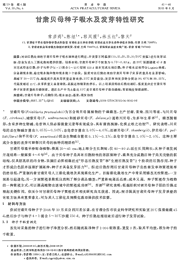NEWS 2010
A study on soaking and germination characteristics of Fritillaria przewalskii seeds
CHANG Yan-li¹, CHEN Yuan¹, GUO Feng-xia¹, LIN Yu-hong², LI Tian³
Acta Prataculturae Sinica 19(4): 41-46 (2010)
¹Gansu Provincial Key Laboratory of aridland Crop Science; College of Agronomy, Gansu Agricultural University; College of life science and technology, Gansu Agricultural University, Lanzhou 730070 China
²Institute of Biotechnology, Gansu Academy of Agricultural science, Lanzhou 730070 China
³The Extension Station of gannanzhou Agricultural Technologies, gannan 747000 China

Abstract
The effect of soaking Fritillaria przewalskii seeds following after-ripening, and the seed germination characteristics at different temperatures (10, 15, 25, 10/20 ºC change), were measured in order to provide theoretical basis for their artificially domesticated cultivation. The 1000-grain ranged from 0.72 to 0.82 g. The seeds completed morphologic after-ripening following storage for 45 d at 20 ºC and physiological after-ripening after seeds were mixed with sand (sand/seed ratio of 4:1) for 150 d at 5-10 ºC. The soaking process fitted a logistic curve, which included sharpe soaking, stable soaking and saturated soaking stages. Under dark conditions, the seed germination quality improved with increased temperature and reached an optimum at 15 ºC with germination rate of 90.67% and germination power of 89.33%. However, when the temperature exceeded 15 ºC, seed germination was significantly reduced and sprout growth was restrained. Temperature was the key condition for seed germination following after-ripening. This suggests that the best time to sow F. przewalskii seeds is under humid and adumbral conditions when the soil temperature is 15 ºC.
